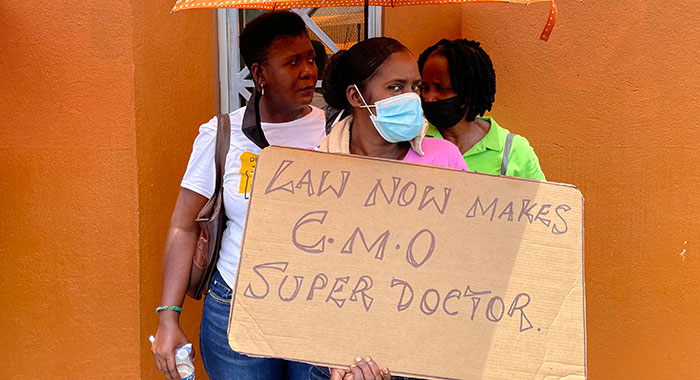The justice of appeal who said he would have dismissed the government appeal in the “Vaccine Mandate Case” has noted that the mandate came into effect even as the infection rate in St. Vincent and the Grenadines was among the lowest in the region at the time.
Hundreds of public sector workers lost their jobs for failing to take a COVID-19 vaccine as mandated by the government in October 2021.
The St. Vincent and the Grenadines Teachers Union, Public Service Union and the Police Welfare Association sponsored a lawsuit and the High Court ruled in favour of the dismissed workers in March 2023.
However, on Feb. 12, the Court of Appeal, in a 2-1 majority vote, overturned the High Court decision and deemed the government’s action as legal.
Justice of Appeal Gerhard Wallbank — who disagreed with his colleagues, Justices of Appeal Eddy Ventose and Paul Webster — noted that SVG was the only Caribbean country that mandated the COVID-19 vaccine, even as its infection rates was among the lowest in the region.
In his dissenting judgment, Justice Wallbank noted that the mandate was highly controversial, attracting both local and international criticism.
“It is notable that this was the only such measure in the Caribbean region at the time,” he said.
Justice Wallbank pointed out that on Oct. 14, 2021, five days before the vaccine mandate was imposed, SVG Government’s figures placed in evidence before the court show that there had been 4,217 reported cases of COVID-19 infection in the country.
This was approximately 3.83% of the population of 109,999, as estimated by the Government, meaning that 96.17% of the population had reportedly not become infected with COVID-19.
Justice Wallbank noted that government figures showed that by Oct. 14, 2021, there had been 42 deaths “from” COVID-19, representing a mortality rate of approximately 0.04% of the population and approximately 0.99% of the reported infections with COVID-19.
The Caribbean Public Health Agency’s (CARPHA) situation report number 198 on Oct. 4, 2021, showed that there had been 1,944,608 confirmed cases of COVID-19 infection in the 35 Caribbean countries/territories, including the 26 CARPHA member states, with 24,354 deaths recorded.
“This represented a mortality rate for those 35 countries/territories of approximately 1.25% of those who had reportedly tested positive for the disease,” Justice Wallbank noted.
For the 26 CARPHA member states, there were 362,694 reported cases and 7,786 reported deaths, representing a mortality rate of approximately 2.15% of reported cases of infection.
At the time, the mortality rate of the reported infections with COVID-19 for SVG stood at less than half of this, at approximately 0.99%.
In terms of the incidence rate for COVID-19 per 100,000 of population amongst CARPHA member states, the three highest were Jamaica, Trinidad and Tobago and Suriname.
SVG was surpassed by 12 states/territories — Aruba, Bahamas, Barbados, Belize, Bermuda, Curacao, Guyana, Haiti, Jamaica, Saint Lucia, Surname and Trinidad and Tobago — all of which had a higher incidence per 100,000 than SVG.
“This warrants observation, as it presents the circumstance that the Government of Saint Vincent and the Grenadines uniquely, in the region, adopted the severe measure of requiring public officers to take the Vaccine on pain of losing their jobs, despite being surpassed in terms of incidence per 100,000 by twelve other States/Territories,” Justice Wallbank said.
“The evidence does not disclose any reason why such a uniquely severe measure should be adopted in Saint Vincent and the Grenadines.”
He noted that the Chief Medical Officer (CMO) Dr. Simone Keizer-Beache testified that she actively monitored national and international data, including CARPHA reports, such as the one mentioned above, which she had put into evidence.
“It was this, and other, information which informed the CMO’s recommendations for the implementation of the vaccine mandate in October 2021.”
By Sept. 27, 2022 — about a year later after the mandate came into effect — the government reported that there had been 9,448 positive tested cases.
“This represented approximately 8.59% of the population as having reportedly tested positive with COVID-19, and approximately 91.41% of the population who had not.
“The Government reported 116 ‘COVID-19 deaths’, a term broad enough to include those who died of COVID-19, as well as directly or indirectly in connection with COVID-19.”
Justice Wallbank said this represented a mortality rate of approximately 1.28% of those who had tested positive for COVID-19, and a recovery rate of approximately 98.72% of those who had tested positive.
“The 116 deaths represented approximately 0.1% of the population. Conversely, 99.9% of the population did not die of COVID-19 and survived,” the judge said.
He further said it must be borne in mind that the government would not have known this a year earlier in October 2021 when it imposed the vaccine mandate.
“No evidence was led in these proceedings to show how these figures compare with infection and mortality rates during historical international epidemics and pandemics. This gap in the evidence is significant because this prevents an assessment of the gravity of COVID-19 in relation to other epidemics and pandemics.”
The judge also noted that the figures are not gradiated with reference to the age of the deceased and the figures do not include hospitalisations.
The government did not put in evidence data for the number of persons hospitalised, nor for the number of hospital beds that had been available or made available.
“This is a gap in the evidence of some significance, as one of the Government’s stated concerns had been that the hospital system and social services should not become overwhelmed with persons requiring treatment. The Court thus has no vision over that aspect of the matter,” Wallbank said.







This man who’s been the country’s leader for 24 yrs, saw the opportunity to gain greater control of the civil service and what better way to do it than by mandating vaccines for civil servants. This mandate has always been about control. Given the opportunity he would have made it mandatory for every Vincentian to be vaccinated. It was a powerful move that a winner, such as our leader, would make.